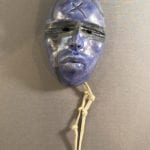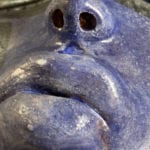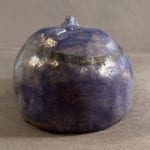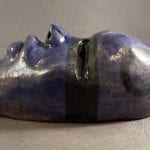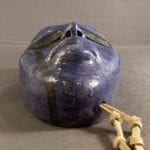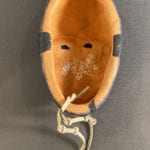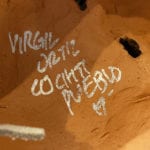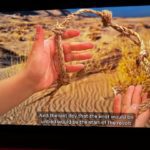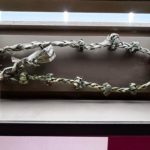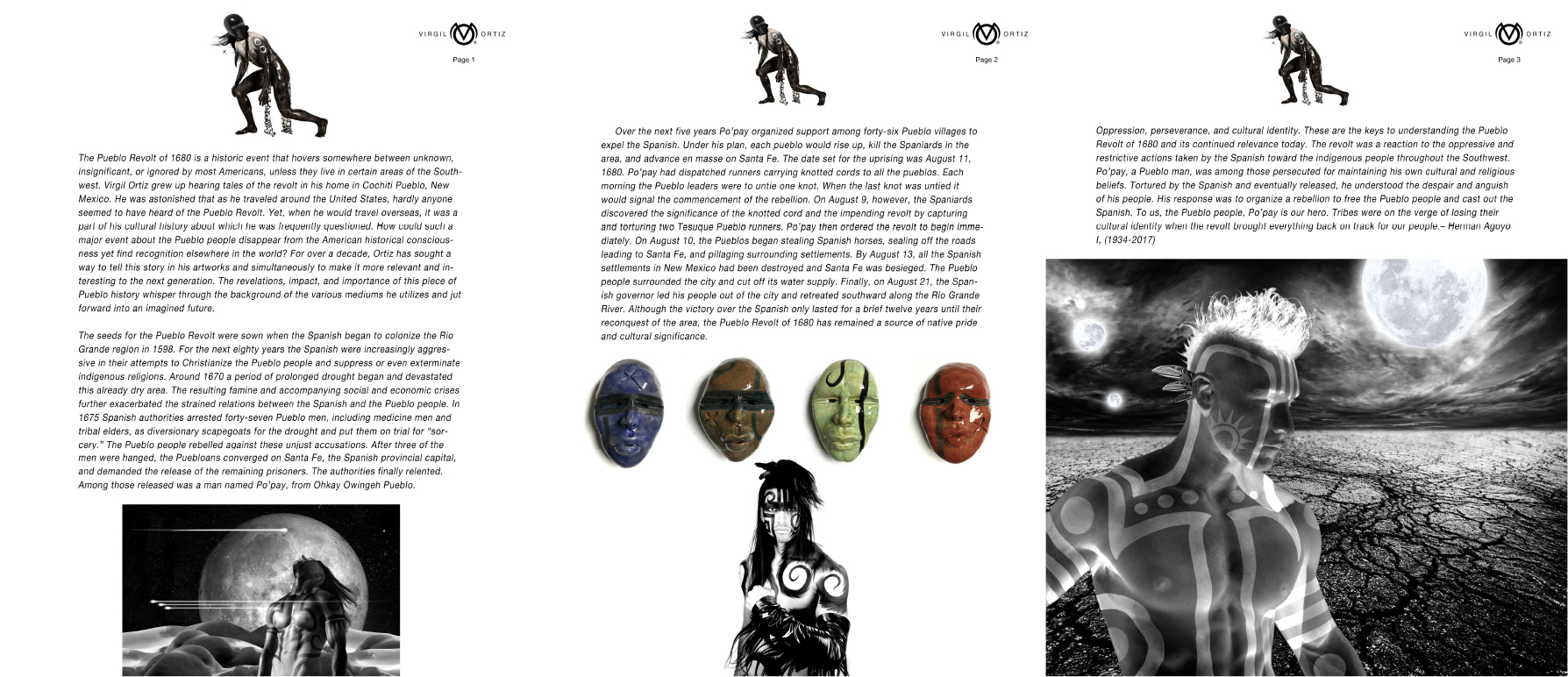The head is 3.06″ wide (ear-to-ear) and 2.375″ deep (nose to back). The walls are about 0.5″ thick. The rawhide is about 4.75″ long.
The clay used for the mask fired a light brick red. The glaze appears to be commercial and fired at a high temperature. However, when the edge of the mask is lightly struck, it emits a dull “thunk,” an indication of a low-temperature firing. In short, I have little idea about how this mask was produced.
When seen is a subdued light, the basic color of the mask is a fairly dark blue. When seen in a bright light, however, this color is strikingly lighter and somewhat splotchy, thus giving the mask a more vibrant and textured look on the uneven clay surface.
Two wide and deep creases begin at the bridge of the nose and span the width of the face. Inset in them are small rectangular holes pierced through the mask indicating eyes. The well-modeled nose has defined nostrils with the interiors unglazed and thus brick red. Similarly the lips are fully-developed and slightly parted, creating a slight concave mouth that is also unglazed and red. These interior unglazed surfaces are not visible to a casual observer but create a subliminal realism. On the forehead is what at first appears to be an incised cross, which would be ironic given the anti-clerical theme of the 1680 Pueblo Revolt, which the mask celebrates. However, as noted below, Virgil intends this to be a turkey track, which represents both the role of Pueblo runners in organizing the revolt and is a form he has adopted as his personal identification mark.
A wide black band spans the entire width of the mask and covers the eyes, much like the markings of a raccoon and conveying the same “outlaw” effect. A thinner black stripe begins at the edge of the mask below the runner’s right chin and runs (with a break for the horizontal black band) just to the right of his right eye onto his forehead, where it arches and then swoops down to form a curlicue, much like an eagle tail on a Nampeyo jar. I do not know the meaning (if any) that Vigil intended by this curvilinear line, but it impresses me as both 1) warpaint, and 2) the circuitous route of the runners from the war council back to their home pueblos.
Two rawhide cords with 2 or 3 knots emerge from a hole in the bottom of the mask. These represent the knotted ropes pueblo runners used to mark time until the planned date of revolt. On the interior, signed in silver paint, is “Virgil Ortiz, Cochiti Pueblo, ’19.”
Charles King, from whom I bought this mask, describes it a follows:
“Born in 1969…, Virgil Ortiz creates dynamic imagery, such as the aeronauts and runners, for his series of the Pueblo Revolt 1680/2180. This mask is inspired by the events of the Pueblo Revolt of 1680. It is made from clay and glazed on the front with purple coloration with black lines over the eyes and side of face. The “Runners” in the Pueblo Revolt in 1680 used tied knots in cords to count down the days to the revolt again the Spanish. Here, Virgil has a leather cord extending out from the bottom of the mask with the tied knots. On the face, there is a “x” or his “turkey track”, which signifies their travels and is also used on almost all his pottery creations…’.”
The citizens of Ohkay Owingeh Pueblo (New Mexico) recreated the knotted yucca cord of 1680 for an exhibit at the Museum of Natural Science, Houston:
(Click on image to enlarge.)
From his perspective as a Pueblo Native, Virgil wrote a 3-page illustrated explanation to accompany the mask. Notice that mask 2019-21 is shown on the left on the bottom of page 2:
(Click on image to enlarge.)
On the King Gallery website, Vigil added:
“The Pueblo Revolt 1680/2180 is a story that I created based on both the historical past and a visionary dystopian future. It is my way to tell our whole story, the history of all nineteen pueblos and what everyone went through. It is a critical story to tell because it is ignored by mainstream history books and in most schools. I had no idea the Pueblo Revolt story would gain so much attention or impact people so deeply…The Pueblo Revolt of 1680 has become the foundation of so many projects for me. …I don’t think the impact of this will ever stop. Hopefully people will understand the story that the pieces are telling. The pottery is truly a timeline to what happened in the past (King, 2017:248).”
Pueblo culture is an oral tradition and one result is that historical events are spoken about in the present and have present impact. Thus, as Vigil demonstrates through his work in clay, his writing and his drawing, the Pueblo Revolt is a strong source of pride among the descendants of those who forced the Spanish out of the southwest for a dozen years. Large pride in this first successful anti-colonialist revolt is the essence of small mask 2019-21.


